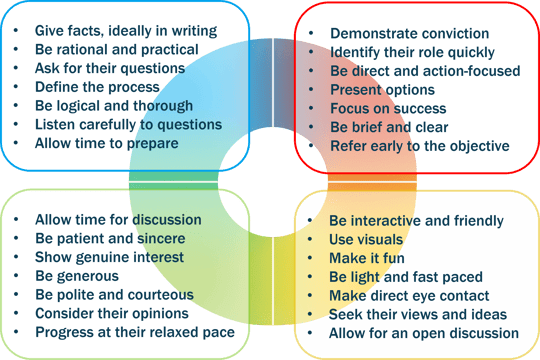
How to use colour preferences to build more effective team communication
Discover how understanding colour preferences can help your team thrive together and achieve even greater success.
In this article, we delve into the fascinating world of colour preference profiling and how it can directly impact how successful your teams are at communicating to understand one another and therefore their overall performance as a cohesive unit.
What are colour preferences?

- Logical and analytical
- Focusses on the details
- Enjoys problem solving
- Needs time for reflection
- Realistic
- Structured and disciplined
- Sticks to their principals
- Bold and determined
- Confident and optimistic
- Task focussed
- Enjoys stretching goals
- Sets a winning mentality
- Thinks big
- Direct and to the point
- Conscientious
- Tactful and diplomatic
- Kind and considerate
- Tolerant and open-minded
- Works for a democratic solution
- Steady and reliable
- Supportive and loyal
- Energetic and enthusiastic
- Friendly and optimistic
- Inspirational and visionary
- Not afraid to take risks
- Spontaneous and imaginative
- Embraces change
- Enjoys networking
Our four colour preferences and their colour combinations affect how we communicate with one another and directly impacts how successful our communication is within our teams.
To understand more about how behaviours can be categorised with psychometric profiling see our article: Why behavioural assessments are more effective in business than personality tests.
The key to remember here is we all possess all four colour preferences but in a personal combination. How we express our combination is unique to us. Understanding this can affect how well we are maximising our own strengths and raise our awareness of how we are impacting others.
Understanding the leading colours of those we work with will give us powerful insight in to how we might be able to work more effectively with them, instead of against them, due to misunderstanding.
The focus of this article is on how our awareness of colour preferences can powerfully affect team communication, so here is an example team:

In this diagram above we have represented each person’s preferred colour combination in a 'C' icon around their profile picture to make it easy and quick to identify.
Each of Daniel’s team members bring a combination of communication strengths to the table.
Self-awareness of what they each bring is step 1; step 2 is to understand what others bring to the team and then learn how to communicate with them, especially those who may be completely different in behavioural style and motivations.
As you can see, Zoe leads with a yellow/blue primary preference. At least one of her top two colour preferences are shared with her team members. This indicates she may find it easier to communicate with her team members than with someone outside of her team who may have the totally opposite colour combination.
The good news is that there are ways she can learn to understand others better and adapt her behaviour to perform better together.
Learn the effective and ineffective ways to communicate with one another according to colour preferences
Here is just one of the ways we do this at C-me, we call this the ‘Dos’ and ‘Don’ts’ of team communication.
This wheel is showing you what to do to communicate most effectively with your colleagues who lead with different colour preferences, or ‘effective’ communication strategies.

Alternatively, this wheel is showing you what to avoid doing, to communicate most effectively with your colleagues – we call this ‘ineffective’ communication behaviour.

When you know your own colour preferences you can then focus on adapting your behaviour with simple actions like the above diagrams illustrate, they are simple but powerful, to improve your team collaboration and address miscommunication and misunderstandings.
Would you like a free C-me profile? Book a demo with one of our team.
Introduce a common language to address anything and everything within your team

Introducing a common ‘language of colour preferences’ is a versatile tool for communication across your organisation.
Here are a few examples of how it can be used:
- Address personal strengths, team strengths and areas for development– clearly and constructively address behaviours that are helpful and also those your people and teams need to grow in. Most importantly, do this in a way that values all colour preferences on the spectrum, but each of these have ‘good day’ and ‘bad day’ expression to be aware of.
- Improve working culture – use colour preferences to build the healthy culture you aim for. Perhaps you want to address inclusivity or diversity or factors affecting performance and productivity; any cultural conversation can be had with a common language of colour preferences.
- Lead more efficient meetings – communicate the focus of a meeting beforehand by using colour to indicate the behaviours you are inviting your people to dial up to achieve meeting goals. For example, you have a meeting where you want everyone to engage in ‘blue sky thinking’, communicate beforehand that this will be a yellow preference meeting so please come prepared to generate and share ideas. You may also want to indicate that this is not the meeting to ask ‘how’ just yet, giving those with a high blue and green preference (who may typically quickly jump to ‘how’) the opportunity to flex their thinking. This is possible because everyone possesses all the four colours but in different measures, so given notice, we can all learn to flex into the different colour behaviours when needed.
- Address miscommunication and misunderstanding – use colours to do this in a non-judgemental way that values all colour preferences and gives insight in to how each colour preference is motivated. This is to help colleagues better understand where others, who may be very different to themselves, are coming from and what their behaviour actually means.
We have taken C-me right into the heart of what we do. We understand that everyone is different, and we have seen that our staff interact best when they know their colleagues’ communication preferences; this has become the foundation of managing and supporting individuals within our teams. We celebrate our differences and openly embrace both strengths and weaknesses. Not only is it the right thing to do, it just works.”
Simon Brown – Managing Director and Founder, ForrestBrown, R&D tax credit consultancy and winner of a Sunday Times best place to work in the South West award
How C-me apply colour preferences
C-me: your go-to platform to facilitate communication, establish trust and drive performance across your organisation
We are experts in team dynamics and the factors affecting performance, through harnessing behavioural preference psychology. We address the soft skills that individuals, teams, and organisations need to build higher performing teams and healthier cultures.
Underpinned by decades of psychological studies and research, some smart algorithms, and hundreds of thousands of jargon-free statements, using our questionnaire and platform we provide our users with some powerful data that speaks to all the people-needs of an organisation.
We use psychometric profiling to gather data and reflect information back on how you, your team, and your organisation as a whole prefer to work and achieve your goals.
On our C-me platform your teams can take their assessment, view and interact with their own profile, view each other’s profiles and preferred ways of working to better understand how to work more effectively together, view their team dynamics in colour wheels that plot everyone’s preferences as a team and organisation, and learn about how behavioural preferences and colours relate.
We have even created a range of workshops to help organisations address some of their greatest needs with colour preference profiling insights such as Communication and Conflict, Stress and Resilience, Leadership Development and more.
Talk to us if you would like help to improve your team communication or discuss how our platform could help you reach your goals.





